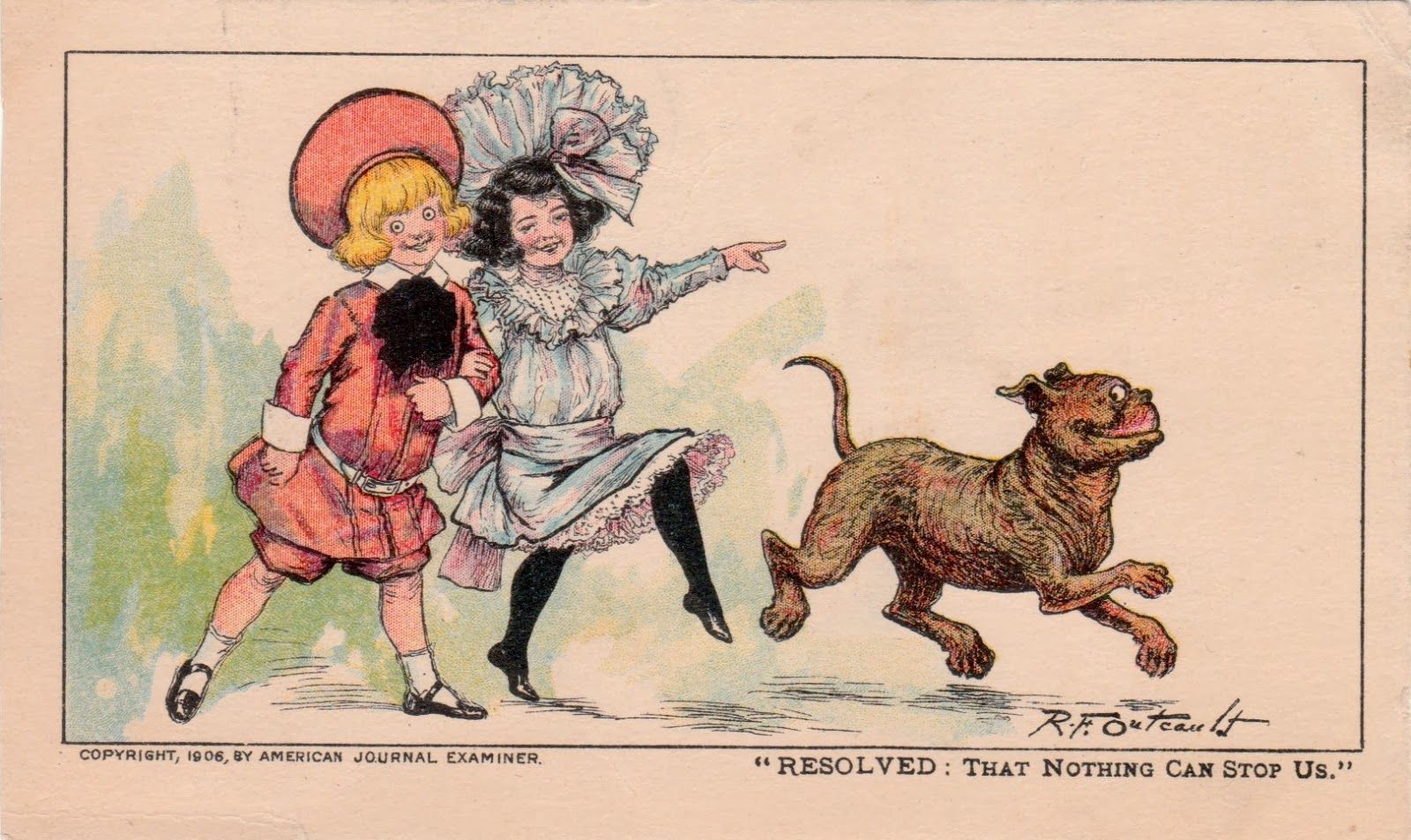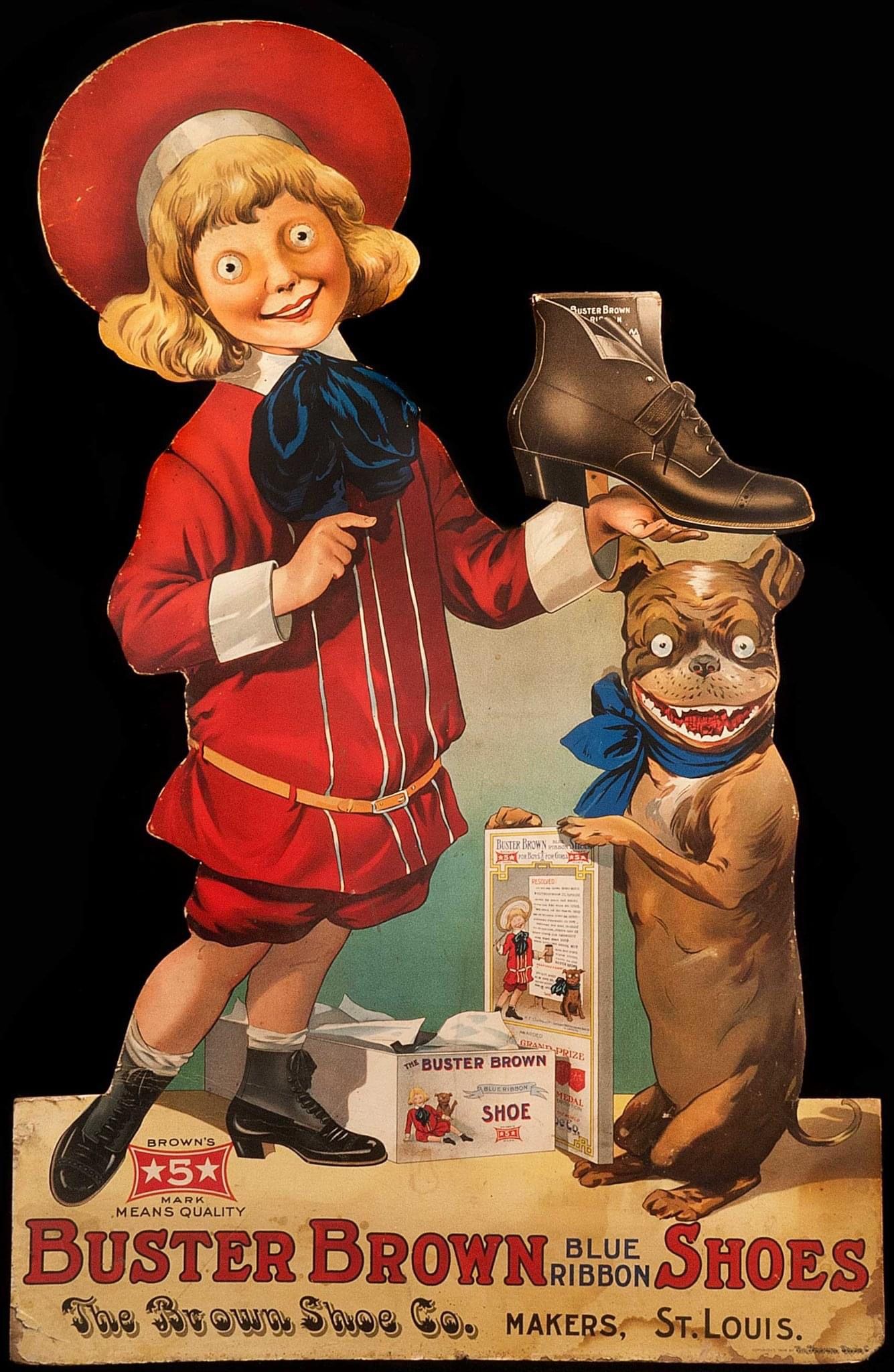Richard Felton Outcault is most notable for creating the first widely popular comic strip character, The Yellow Kid, for the New York World in 1895. Only slightly less notable is the fact that he also created the first widely licensed comic strip character, Buster Brown, for the New York Herald in 1902. Interestingly, the latter seems to have had a much larger effect on American culture than the former, due to the popularity of one particular license.
Buster Brown was a comic strip about a mischievous boy with relatively wealthy parents, who generally gets into some kind of trouble in every comic strip, gets spanked for it, and resolves to never do it again. As you can imagine, despite his resolutions he continues to do the same thing again, and the cycle repeats. He is assisted in his mischief by his dog Tige, who can "speak" but seemingly only in a language that Buster can understand. He is also often accompanied by a girl, Mary Jane, who is more well-behaved, though she does get involved in some of Buster's troublemaking from time to time. Mary Jane's relation to Buster is unclear. Some sources I found describe her as Buster's sister, some as his best friend, others as his girlfriend, and still others as his "sweetheart." The strip itself is also unhelpful. Their relationship isn't mentioned, at least in the strips I saw, though it's implied that they live in the same house. This could indicate that they're siblings, but she doesn't seem to appear in many earlier strips that take place at the Brown home. They do appear to be very good friends, though that wouldn't necessarily mean they aren't siblings. Outcault has stated that the character of Mary Jane is based on his own daughter, Mary Jane, though that is also the name of his wife. I'm not sure if this is the case, but given those facts it might be possible that the character is simultaneously Buster's sister and his "sweetheart," however odd that may seem.
Outcault was quite the entrepreneur when it came to licensing his characters, and offered to sell the Buster Brown license to just about anyone who wanted it. The story goes that in 1904, at the St. Louis World's Fair, he approached roughly 200 different companies and sold them one, though I have a feeling that number is a bit exaggerated. Still, it meant that almost any product you could imagine either had Buster's name on it or was being advertised using his likeness, or both. The license sales were done despite the fact that Outcault didn't own the copyright to Buster Brown, as that was firmly in the hand of the New York Herald newspaper. Of course, copyright of cartoon characters was a bit murkier in those days, and besides, as we've seen, a copyright or trademark owned by someone else has never stopped enterprising men from trying to make money off of it.
Either at the aforementioned 1904 World's Fair or earlier, Outcault also sold a license to the Brown Shoe Company. A representative of the company, John Bush, approached Outcault and made an offer, thinking the connection between the already established name of the company, Brown, and the name of the character, Buster Brown, would make Buster a good fit as an advertising mascot. While it's possible the license was obtained prior to the World's Fair itself, Buster was at the very least introduced as the mascot of Brown Shoe Company during the Fair. At the Fair, and at subsequent advertising events, the company would hire little people to dress up as Buster and hold signs advertising the shoes, next to dogs dressed as Tige.
It didn't stop at advertising, however. The company also introduced two new styles of children's shoes, the Buster Brown, a lace-up shoe for boys, and the Mary Jane, a single strap shoe for both boys and girls. Interestingly, Buster Brown himself can be seen in the comic strip and other appearances wearing both Mary Janes and Buster Browns. Both Buster Browns and Mary Janes proved to be very popular over the years, but the popular perception of Mary Janes changed. While originally meant as a unisex shoe, the overall shape and design of the Mary Jane became associated more with girls' and women's fashions as the years went on. Eventually, the company introduced adult Mary Jane styles, which became as popular with women as the children's shoes did, and remain so to this day. While it was previously a brand name, these days Mary Jane is used to refer to any shoe with that particular style.
The Brown Shoe Company still exists, though not under the same name. In 2015 they changed their name to "Caleres," and seemed to do everything they could to shed the baggage associated with their old name, including Buster Brown. The only mention of him on their website is on the "Our History" page. A previous version of the website had a page dedicated to Buster, and even a modernized Buster Brown logo, but neither can be found on the current website. The trademark for Buster Brown and Mary Jane also seems to have lapsed, though I'm not sure how much use anyone would get out of them anymore. Mary Jane has entered into common usage as the name for that particular type of shoe, so it would be impossible to trademark it anyway. While the characters are not well remembered anymore, their names have lived on.
For more information:
Outcault, Goddard, the Comics, and the Yellow Kid from The Comics Journal
Buster Brown Shoes and Mary Janes at America Comes Alive
Whatever Happened to Buster Brown Shoes? at The Straight Dope
Buster Brown at Encyclopedia Britannica
Buster Brown: The Iconic Comic-Strip Character and Shoe Mascot at Toonsmag
Buster Brown: Marketing A Name at Library of Congress
The Life and Times of Buster Brown, archived version of Brown Shoe Company history page
Why did Brown Shoe Company Change Its Name To 'Caleres'? at St. Louis Public Radio
Our History at Caleres

